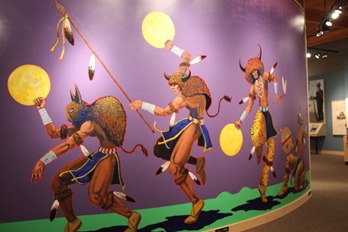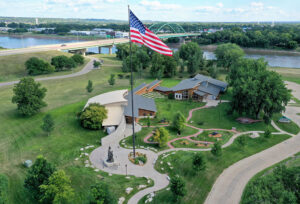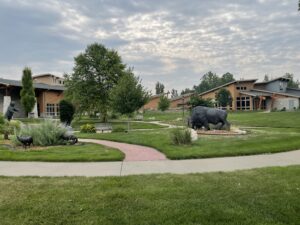The Lewis and Clark Expedition traveled through land populated by a variety of tribal nations. They were charged with making friends, gathering information about their language, traditions, laws, and customs. The journals of the Captains show that the Corps survived because of the different tribes’ assistance and generosity.
The Center continues to move forward on its permanent mission of “Commemorating a history of encounters.” To recognize the tribes of the area, the Sioux City Lewis and Clark Interpretive Center includes them in various ways to promote dialogue, harmony, and understanding among all people in this region.
St. Augustine Photo Exhibit
The historic St. Augustine Indian Mission School is on the Winnebago reservation, 22 miles southwest of the Sioux City Lewis & Clark Center. Founded by St. Katharine Drexel in 1909, the Mission enrolls more than 125 children of varied faiths and heritages. It is rooted in Catholic Identity and Native American Culture. The K—8 students study traditional language and culture along with core academic basics. Beginning in 2006, fifteen to seventeen students were photographed in their Native regalia. Filling the hallway at the Center are beautiful photos of these students who state their hopes for the future. Every year a new set of portraits are displayed in this special exhibit. In addition, the photos are used in a calendar that promotes the Mission and its endeavors. The calendars are free to visitors and members in January each year.
“The interpretive center’s post Bicentennial Native cultures focus opens the door to so many opportunities for enlightenment about Native people in our area,” said Fr. Dave Korth, then Director of St. Augustine Indian Mission in a press release from the first exhibit in 2006. “It is an opportunity to show visitors from Siouxland and beyond our children’s gifts and talent. For our children, it is an opportunity to foster pride in their heritage.”
The exhibit is now in its 16th year. The photos while showing the beauty of the children also inspire others to dream of a future for all children. The calendars continue to be a much sought after item.
“Encounters” Pictographs
Contemporary Winnebago (Ho-Chunk) artist Henry Payer, Jr. used traditional Plains Native Art form known as ledger-style drawing to interpret encounters along the Missouri River in this region during the time of Lewis and Clark. The pictographs he created for the Center’s wall show people intermingling, trading, and sometimes at war. According to Payer, a pictograph “can tell a story better than a very detailed painting.” “Encounters” travel across the wall (right to left) from the sun to the moon with a series of meetings depicted. The images show a nomadic people, who just finished trading, who are dressed for war, or who are courting. Taking the time to stop and “read” the images is a way to learn and understand another culture.
“Buffalo Dance”
Another wall of our center is honored to have another Henry Payer, Jr. painting. The vibrant mural shows four Native men engaged in a ceremony of dance, music, song, and prayer as a prelude to the buffalo hunt. Most Plains Indians prepared for the buffalo hunt with a ceremony to call the buffalo near and to ensure a success. In the mural, visitors find traditional symbols of Winnebago (Ho-Chunk), Osage, Pawnee, Santee, Mandan, and Arikara.
Native Games
The Center’s Traditional Native Games exhibit includes more than two dozen traditional Lakota games crafted by Lakota artist Mike Marshall of Rosebud, South Dakota. One example is a game of catching deer bones with a needle, much like a modern game of catching a ball on a stick. Another game is similar to bowling; “Game of Bowls” is played with two small wood cylinders and small stone balls; the goal is to knock over the competitor’s cylinder. Along with the games in their cases, the walls have art work showing the games being played. One, titled “Sioux Elk Game,” is by noted Native artist Oscar Howe, a Yanktonai Sioux.


Painted Buffalo Robe
Our center also has a Native woman modeling a contemporary Lakota painted buffalo robe over a calico dress. Next to her is a panel explaining the use of buffalo robes. The women decorated robes for their use; the men used pictographic art to proclaim prestige as warriors and hunters. A painted buffalo robe is among the most prized artifacts of the Lewis & Clark Expedition.
In 2022, year the Center had The Many Moccasins Dance Troupe, an international and professional Native American dance ensemble, here to dance as we celebrated our 20th anniversary. The Sioux City Lewis and Clark Interpretive Center is proud to fulfill its mission “to create a home for dialogue that fosters understanding and peace among people who were in this area before Lewis and Clark, those who came after, and those who continue to make their home in this region.”





